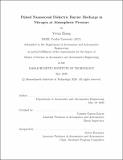Pulsed nanosecond dielectric barrier discharge in nitrogen at atmospheric pressure
Author(s)
Zhang, Yiyun(Aerospace scientist)Massachusetts Institute of Technology. Department of Aeronautics and Astronautics.
Download1191836272-MIT.pdf (9.222Mb)
Other Contributors
Massachusetts Institute of Technology. Department of Aeronautics and Astronautics.
Advisor
Carmen Guerra-Garcia.
Terms of use
Metadata
Show full item recordAbstract
Small power devices are of strong interest as many electronics are made more compact. Those portable power sources are widely used in aerospace applications such as small UAVs and satellite thrusters. Typically, these portable devices rely on batteries, but small power generators based on hydrocarbon fuel micro-combustors have much higher energy densities. However, flame instability and extinction are difficult to avoid at small scales. Because of the high surface to volume ratio, significant heat loss and radical quenching at the walls take place. To address this challenge, plasma has shown capabilities in facilitating combustion through thermal, kinetic and transport effects. In this work, a preliminary study of plasma discharge at atmospheric pressure is conducted as the first step to understand Plasma-Assisted Combustion (PAC) at micro scales. Among various electric discharge mechanisms, Dielectric Barrier Discharge (DBD) is chosen due to its ability to generate non-thermal plasma at atmospheric pressure with a simple geometry and a low power consumption. Repetitive Pulsed Nanosecond Discharge (RPND) technique is also studied. It provides repetitive high voltage pulses on the order of 10 - 20 nanoseconds and is a common technique in non-equilibrium plasma generation. A 1D DBD model is constructed for a volume discharge. It couples particle continuity equations with Poisson's equation, and solves for electric field and charged particle number densities. The numerical model is discretized in space and time to obtain charged particles evolution and electric properties. The model is firstly validated with open literature for both AC and RPND, and is then applied to our DBD setup at atmospheric pressure. In addition, a nitrogen (and air) discharge experiment is designed and operated with RPND. Preliminary results show the capability to generate sustainable and uniform plasma at atmospheric pressure. The appearance is that of a uniform glow plasma free of micro-discharges. Several experimental findings help to understand the discharge physics and set a foundation for future applications in micro-scale combustion.
Description
Thesis: S.M., Massachusetts Institute of Technology, Department of Aeronautics and Astronautics, May, 2020 Cataloged from the official PDF of thesis. Includes bibliographical references (pages 85-87).
Date issued
2020Department
Massachusetts Institute of Technology. Department of Aeronautics and AstronauticsPublisher
Massachusetts Institute of Technology
Keywords
Aeronautics and Astronautics.